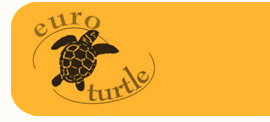Structure
of the Human Skeleton
This section looks
at the structure and function of the Human Skeleton.
Introduction:
The human skeleton is made up of 206 bones although we are born with
300: during childhood many of these fuse/join together to form single
bones. The skeleton is divided into two parts:
- The Axial skeleton - skull,
backbone and ribcage
- The Appendicular skeleton
- limbs and girdles
The human skeleton is designed
to stand upright on the hind limbs (bipedal) to enable walking on two
legs. It has the added advantage of freeing the upper limbs which can
then pick-up and carry objects.
The layout of the skeleton:
The diagram below shows a front view of a human skeleton. To
find out more about each of the parts, click on appropriate bone.
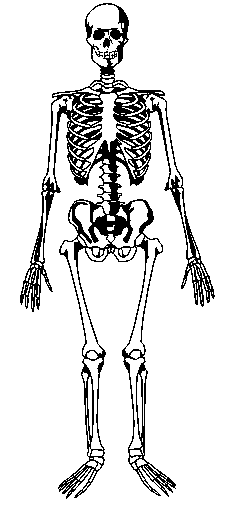

Hands:
Our hands are built on the standard mammal five-digit plan. The
wrist bones provide anchorage for the small muscles that help to move
the thumb and fingers. Other finger-moving muscles are in the forearm,
conected to the fingers by long tendons that run through a "collar" of
ligaments in the wrist.
The human hand is also unique because it can oppose/touch its thumb
to each finger which enables it to pick up and handle objects in a precise/exact
fashion.
.gif)

Legs:
We are so used to standing all the time in our lives, that we
are not aware of what an amazing balancing feat this is. Other animals
may be able to stand on their hind limbs briefly, but they cannot stay
standing for long. Compared to the arm, the bones
of the human leg are much thicker and stronger to carry the body's weight,
all the time.
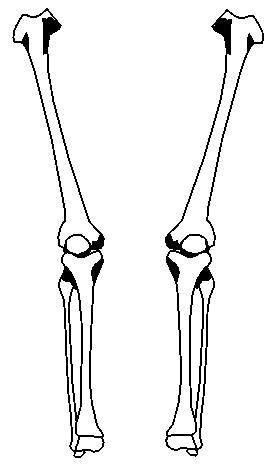

Arms:
Dozens of times a day, we reach for something, pick it up with our fingers,
and move it or use it in a precise way. The arm stretches out, so that
the hand can use something, and is vital to do things
in life. The arm is controlled by two antagonistic muscles: the triceps
and the biceps, which work together to raise and lower the arm. Without
arms it would be almost impossible to do anything.
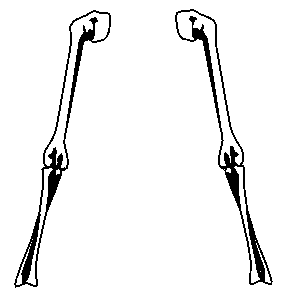

The
pelvis:
The human pelvis is an oddity in the animal world. As most other animals
move on four limbs most of the time, they have elongated pelvises. Because
we walk on two legs, our pelvis has become distorted to its rounded
shape. The name pelvis comes from Latin - pelvis meaning a basin. The
bowl shape of the pelvis gives protection to the internal parts of the
lower body, such as the intestines and bladder, and in women especially
the womb.

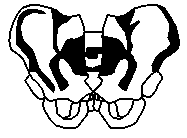
Skull:
Although the head is at one end of the human body, it functions
as the body's centre. The skull protects the brain, the controller of
the whole body from the outside world, from knocks and bangs. The skull
consists of the jaw, the nose hole, the eye holes, the nerve holes,
the ear holes, and the tooth holes.

 Spine:
Spine:
The spine is the backbone of the human body. It forms a vertical supporting
rod for the head, arms and legs.
It allows us to do many movements that we take for granted, yet it was
originally designed as a horizontal girder, to take the weight of the
chest and abdomen. Each vertebra can only move a little in relation
to its neighbours, but over the whole spine they enable the back to
move in all directions.

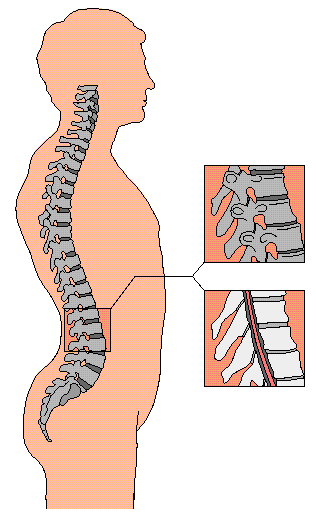

Ribs:
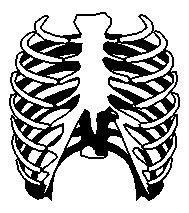
The lungs need to inflate
and deflate, becoming larger and smaller as they breathe; yet they also
need protection against being knocked and crushed. A solid cage like
the skull would be too rigid, so we have the ribs
- made up of moveable bars. They are very strong and flexible, and absorb
knocks. When breathing in, muscles lift the ribs upwards and outwards,
increasing the volume of the chest and sucking air into the lungs.

The
feet:
The human foot has become specialised for walking. Our tiny toes
have lost the gripping ability found in our close relatives, the apes.
The human foot bears the weight of a whole body and has to provide a springy
base to push the body off the ground when walking. The main foot bones
are mostly enclosed in the fleshy part of the sole. They are visibly separate
only at the ends, where they project into each toe.
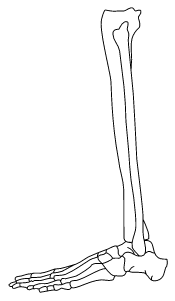

|
|


